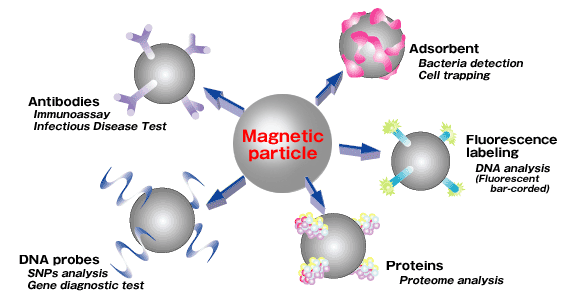Nowadays, magnetic beads are considered a powerful tool for a variety of research and medical applications. Coupling of magnetic properties with specific ligands in magnetic beads allows the separation and purification of cells, proteins, nucleic acids, and other molecules in a highly efficient and specific manner. In fact, this technique has driven a technological revolution in biological research.
Magnetic beads come in different compositions, sizes and shapes that determine their chemical and physical properties. Therefore, it is essential to choose the most suitable type of magnetic beads for each specific purpose. Additionally, the selection of the separation method is important to assure reproducibility and efficacy of the protocol. Magnetic beads can be coupled with ligands that target specific molecules and make these protocols highly versatile. For isolation of certain cell types or proteins, magnetic beads can be conjugated with specific antibodies. However, there are alternatives that allow the application of magnetic beads to more diverse targets.
The selection of the most appropriate magnetic bead and ligand as well as other parameters can be difficult, therefore Sepmag prepared a free guide for you to help you decide when preparing such protocols .
Bioseparation is perhaps the most widespread use of magnetic beads. This technique is performed in vitro by coating the beads with a ligand specific for the target molecule or cell type. The application of an external magnetic field is used to isolate cells or molecules of interest directly, by positive selection, or indirectly, by negative selection. Superparamagnetic beads are ideal for these applications since they only have magnetic properties when exposed to a magnetic field and do not alter the viability or biological functions of the target cells. This allows scientists to isolate and study rare cells in order to unravel the most elusive physiological mechanisms. Furthermore, the isolated cells can be used for transplantation in order to repair tissues and treat specific medical conditions. Examples of such applications are the isolation of endothelial colony-forming cells to study the pathophysiology of a lung disease1, and the isolation of connective tissue progenitors for use in bone repair therapy2.
However, the use of magnetic beads is not limited to bioseparation in research. It also has applications in medicine, and in industrial processes. Medical applications include targeted drug delivery, magnetic resonance imaging, diagnostics and targeted destruction of tumors by intercellular hyperthermia. Drug delivery can be targeted to specific tissues by loading of magnetic beads with the pharmacological agent and applying the magnetic field to accumulate the drug only where it is needed. This technology is particularly useful for treatment of cancers.  By administering magnetic beads that bind specifically to tumor cells, an external high-frequency magnetic field can be used to induce a localized hyperthermia reaction that reduces the tumor’s viability and increases its susceptibility to traditional therapies. Furthermore, magnetic beads can also be used as contrast agents for magnetic resonance imaging. Since these particles can be engineered to produce tissue-specific signals, this method is useful for detecting solid tumors and metastases3. In diagnostics, magnetic beads can also be a tool for sensitive detection and separation of circulating tumor cells, even when their percentage in the cell population is very low, which allows the detection of metastases in blood samples4. In industry, magnetic beads have applications from the optimization of bioengineering processes to the oil industry. Bioengineering applications of magnetic beads are relevant for example for the optimization of bioreactors5. In industry, magnetic beads can also be used to isolate and capture enzymes or other molecules of interest, increase the contact between enzymes and substrates, or retrieve the molecules of interest from the media, which can be vital for the efficacy of enzymatic reactions. In the oil industry, magnetic polymer beads have potential for the more efficient recovery from wells by blocking the water flow and for the release of chemicals inside the well in a controlled and directed manner3.
By administering magnetic beads that bind specifically to tumor cells, an external high-frequency magnetic field can be used to induce a localized hyperthermia reaction that reduces the tumor’s viability and increases its susceptibility to traditional therapies. Furthermore, magnetic beads can also be used as contrast agents for magnetic resonance imaging. Since these particles can be engineered to produce tissue-specific signals, this method is useful for detecting solid tumors and metastases3. In diagnostics, magnetic beads can also be a tool for sensitive detection and separation of circulating tumor cells, even when their percentage in the cell population is very low, which allows the detection of metastases in blood samples4. In industry, magnetic beads have applications from the optimization of bioengineering processes to the oil industry. Bioengineering applications of magnetic beads are relevant for example for the optimization of bioreactors5. In industry, magnetic beads can also be used to isolate and capture enzymes or other molecules of interest, increase the contact between enzymes and substrates, or retrieve the molecules of interest from the media, which can be vital for the efficacy of enzymatic reactions. In the oil industry, magnetic polymer beads have potential for the more efficient recovery from wells by blocking the water flow and for the release of chemicals inside the well in a controlled and directed manner3.
Magnetic beads provide a solution that could revolutionize diverse fields of biological research by increasing the efficacy of cell isolation protocols, improving current bioimaging techniques, and providing alternatives for tumor diagnosis and treatment. The relevance of magnetic beads in research is unquestionable since it allowed a technological leap, by optimizing essential laboratory techniques such as isolation of biomolecules, PCR and ELISA. In the rapidly evolving field of biological research, magnetic bead technology shows promise for further technical innovation.
By Lluís Martínez, PhD, Sepmag
References:
- Alphonse, R. S. et al. The isolation and culture of endothelial colony-forming cells from human and rat lungs. Nat. Protoc.10, 1697–1708 (2015).
- Joshi, P. et al. Circular Halbach Array for Fast Magnetic Separation of Hyaluronan-Expressing Tissue Progenitors. Anal. Chem.87, 9908–9915 (2015).
- Philippova, O., Barabanova, A., Molchanov, V. & Khokhlov, A. Magnetic polymer beads: Recent trends and developments in synthetic design and applications. Eur. Polym. J.47, 542–559 (2011).
- Karabacak, N. M. et al. Microfluidic, marker-free isolation of circulating tumor cells from blood samples. Nat. Protoc.9, 694–710 (2014).
- Li, D., Fu, Y.-J. & Rusling, J. F. Characterizing protein modifications by reactive metabolites using magnetic bead bioreactors and LC-MS/MS. Chem. Commun. (Camb).51, 4701–4703 (2015).












Thank you for the insight and sharing your opinion with us!
This article is very interesting.I think every cells has a power of magnetic properties in a magnetic field.the cancerous cells change their magnetic prope.rties rather normal others. and we can screening these cells by this manner.
I hope the best wishes for all reaserchers..